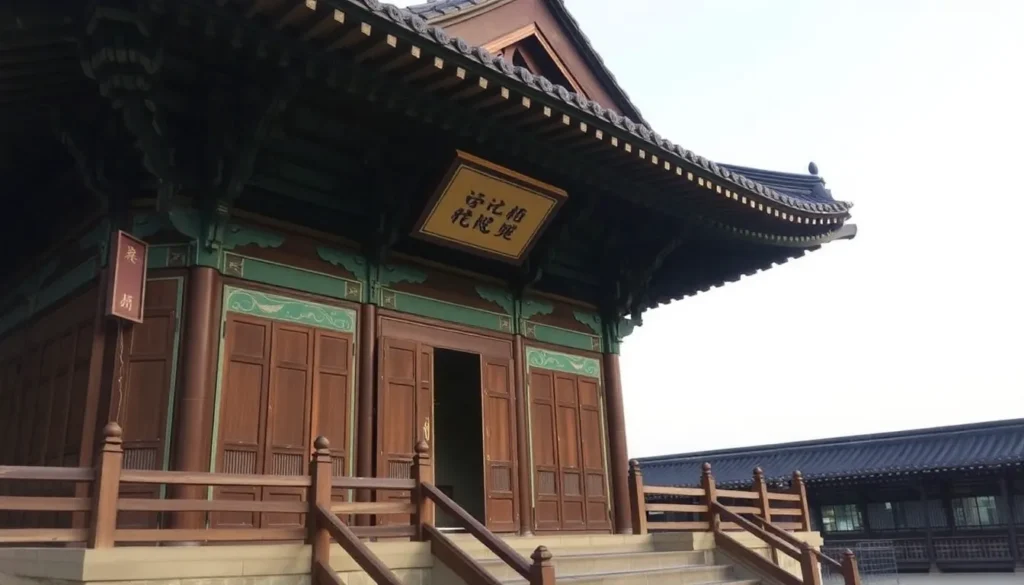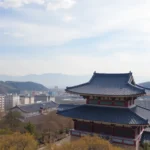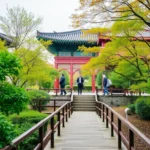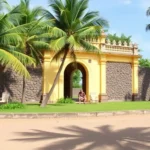Sleeping in a Temple in Korea: Experience at Haeinsa Temple

Experiencing the tranquility of a temple stay in South Korea is not just a travel experience; it's a transformative journey into the heart of Buddhist culture. If you're planning a trip to this beautiful country, immersing yourself in the unique practice of templestay should be on your must-do list. In this article, we will explore everything you need to know about staying in a temple, with a particular focus on our unforgettable experience at the Haeinsa Temple, one of the most revered sites in Korea. For an authentic experience, consider the Haeinsa temple stay program, which offers a unique opportunity to connect with the peaceful Buddhist lifestyle.
Not only will we delve into the history and significance of Haeinsa Temple, but we will also share practical tips on how to make the most of your templestay experience. Get ready to step into a world where peace and spirituality reign.
Understanding the concept of templestay
The concept of templestay refers to the opportunity to spend one or more nights in an active Buddhist temple, where you will live alongside a community of monks. This immersive experience allows participants to gain insights into the core tenets of Korean Buddhism, engage in daily routines, and partake in communal meals and meditative practices. You can expect to join the monks in morning prayers, including the rigorous 108 prostrations aimed at cleansing oneself of the 108 human afflictions.
Many temples have dedicated dormitory spaces for visitors, and it's not just a foreign experience—many Koreans also partake in templestays, making it a culturally enriching activity. The facilities can vary significantly among temples, ranging from shared dorms to private rooms with modern amenities.
Upon arrival, many tourist-friendly temples will provide an orientation session in English, outlining the daily schedule and activities. This session usually includes a tour of the temple grounds, helping visitors familiarize themselves with their environment.
Activities during your templestay may include:
- Morning prayers around 4:30 AM
- Shared meals, often vegetarian and simple
- Participating in additional ceremonies
- Engaging in workshops and nature walks
Programs can differ between weekdays and weekends, with options for longer stays that may include unique activities. Many visitors prefer a single night for a less hectic schedule, allowing for more free time to soak in the serene atmosphere.
The role of Buddhism in Korean society
While religion may not be a focal point for many South Koreans today—approximately half of the population identifies as atheist—Buddhism has played a significant role throughout history. Buddhism was introduced to Korea in the 4th century from China and became the official religion during key historical periods, including the Silla and Goryeo dynasties. Aunque enfrentó represión durante la temprana dinastía Joseon en favor del confucianismo, el budismo mantuvo su importancia e influencia.
Today, there are countless historic Buddhist temples across South Korea, contributing to the country’s rich cultural heritage. Many of these temples are UNESCO World Heritage Sites, making them essential stops for any visitor, including the famous Haeinsa Temple stay, which attracts many travelers seeking spiritual enrichment.
Booking your templestay experience
Booking a templestay is straightforward through the website templestay.com, which lists most participating temples. Here, you can select your desired temple, check availability, and make reservations. Be sure to specify your travel dates and the number of guests.
Payment can be made via credit card at the time of booking, and most reservations allow free cancellation, so read the terms carefully. Pricing typically ranges from 50,000 to 80,000 KRW per person for weekdays, with slightly higher rates on weekends. Additionally, many temples, including Haeinsa, offer detailed descriptions, photos, and amenities to help you choose the best fit for your stay.
Don't forget to carry a Revolut card or a N26 card to minimize foreign transaction fees.
Top temples for templestay in South Korea
While South Korea boasts numerous temples offering templestay programs, here are some of the best options to consider:
- Haeinsa (Gaya-myeon)
- Bongeunsa (Seoul)
- Beomeosa (Busan)
- Bulguksa (Gyeongju)
- Beobjusa (Songnisan)
- Baegyangsa (Bukha-myeon)
Experience templestay at Haeinsa Temple
Haeinsa Temple was our choice for the templestay, and we highly recommend it. Here’s a glimpse into what makes this temple so special and our personal experience during our stay.
The significance of Haeinsa Temple
Haeinsa is not only one of the best places for templestay experiences, but it is also one of the three most important Buddhist temples in Korea, alongside Tongdosa and Songgwangsa. Founded in 802 AD, its significance largely stems from the Tripitaka Koreana, a collection of over 80,000 wooden tablets inscribed with Chinese characters that encompass the teachings of Buddha. This collection is the largest of its kind in the world.
Created in the 13th century by skilled artisans, these wooden tablets were meticulously crafted to minimize errors, with a technique that involved tracing texts onto wood after initial drafts. Korea is renowned for its advancements in script during this period.
Moreover, the building housing the Tripitaka, known as Janggyeong Panjeon, is a masterpiece of architecture built over 600 years ago. Its design features windows of varying sizes and ventilation holes, creating optimal conditions for preserving this invaluable treasure. Recognized as a UNESCO World Heritage Site in 1995, it stands as a testament to Korea's architectural prowess.
Haeinsa Temple is nestled in the heart of Gayasan National Park, surrounded by lush forests, streams, and mountains, offering a serene and picturesque atmosphere. The beauty of the temple grounds, coupled with the tranquility of nature, makes it a must-visit. For an unforgettable experience, the Haeinsa templestay program truly encapsulates the essence of this sacred space.
Our templestay experience at Haeinsa
We made our reservation a month in advance through the recommended website to secure our spot. We opted for a double room during our weekday stay, paying a total of 170,000 KRW (approximately 120€). Following our booking, we received a confirmation email, and a few days before our arrival, we were contacted with check-in details set between 2:30 PM and 3:30 PM.
Arriving at the designated time, we went straight to the information office, where we were given a uniform consisting of loose, comfortable pants and a colorful vest, which we were required to wear during our stay to be recognized as guests within the temple.
Note: Adhering to the behavioral norms expected in a Buddhist temple is crucial. Show respect to the monks whenever you encounter them, maintain silence, limit phone use, and avoid any affectionate gestures with your partner.
At 4 PM, we gathered for a orientation session with other guests, where the daily schedule was explained. We watched an informative video and had the opportunity to ask questions. Subsequently, a tour of the temple's facilities and pavilions was conducted, including the building housing the Tripitaka.
We later reconvened at 5:35 PM for dinner, sharing a simple vegetarian meal with the resident monks. The atmosphere was respectful and quiet, with an emphasis on finishing our meals promptly without lingering.
After dinner, we participated in the ceremony of the four instruments. Through the sounds of a drum, bell, wooden fish, and a cloud-shaped gong, prayers were offered to all beings in the universe. As dusk fell, we strolled around the temple grounds before heading to bed, where we enjoyed the best night’s sleep of our trip!
In our blissful state, we overlooked the 4 AM alarm—actually, we missed the 5 AM and 6 AM alarms too! Thus, we skipped the morning Yebul ceremony (held at 4:40 AM) and breakfast (at 6 AM). Since we visited during the week, the program was limited to these activities, but weekend schedules often include more engaging options. For those considering a visit, the temple stay Haeinsa is an experience that shouldn’t be missed.
We were informed that check-out was at 11 AM, allowing us some extra time to explore the surrounding nature. A trail begins at a bridge about 200 meters away, running parallel to the river and leading to Mount Sangwangbong. Although the entire hike is 4 km one way with a 19% incline, we only ventured the first kilometer.
While food is typically served around check-out time, we decided to take a taxi to continue our journey, turning our sights towards Daegu for the day.
How to reach Haeinsa Temple
The most convenient route to Haeinsa is from Daegu. Intercity buses depart from the Seobu Bus Terminal approximately every hour during the morning, taking about 1 hour and 30 minutes for a fare of 8,500 KRW.
The bus will drop you at a village about 3 km from the temple, known as Haeinsa Temple Intercity Bus Terminal, where you can either take a taxi for about 7,000 KRW or walk, although the uphill trek can be challenging.
For your return trip to Daegu-Seobu, buses leave from the same location at various intervals throughout the day. For example, departures are at 08:00, 08:40, 10:00, and many others (confirm the schedule beforehand). Payment is collected in cash by the bus assistant.
You can also reach Haeinsa via the town of Goryeong, where buses run every 40 minutes to the temple.
This was our incredible experience staying in a Buddhist temple in South Korea at the Haeinsa Temple. Have you visited this site? Did you have a similar experience? If you’re planning a trip to South Korea, make sure to consider the Haeinsa templestay for an enriching cultural experience.
| Save on your trip |
| Compare and find cheap flights here |
| Find accommodation at the best prices here |
| Book activities and tours in Spanish here |
| Get a 5% discount on your travel insurance from IATI here |
| Reserve airport transfers here |
| Learn how to withdraw money without fees here |
| Rent a car with the best deals here |
| The best books and travel guides here |
| All our articles about South Korea |






Deja una respuesta